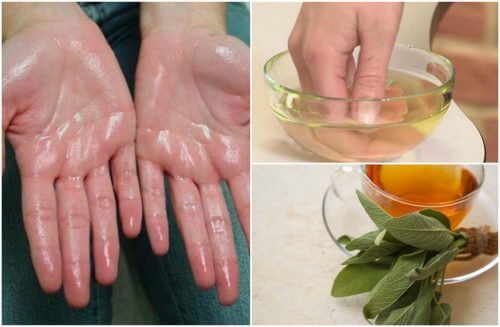7 Great Natural Remedies for Sweaty Palms

Plantar hyperhidrosis, or excessively sweaty palms, is an uncomfortable condition. It’s very common, and usually happens because of an over-stimulation of your nervous system. This condition causes a change in your sweat glands. What that does is make your body sweat more, especially in stressful or anxiety-filled situations.
Having this condition can have a big impact on your self-esteem and social life because it’s constant and gets in the way of even simple things like shaking or holding hands. Luckily, there are several natural remedies for sweaty palms. Thanks to the properties of their ingredients, they help reduce this problem before it affects your quality of life.
Today, we’re going to go into detail about 7 great options. Give them a try!
Natural remedies for sweaty palms
1. Apple cider vinegar
Apple cider vinegar is an astringent tonic. It also contains large amounts of tannic acid. This substance helps reduce pore size and excessive fluid secretion.
How do you use it?
- Mix the apple cider vinegar with equal parts water.
- Then, rub it on the palms of your hands two or three times per day.
2. Sage tea
Drinking sage tea is a good way to get sweaty palms under control from within your body. The properties of this plant promote control over your hormonal activity. It also fights changes in your sweat glands.
You might like: 6 Body Parts You Should Massage
How do you use it?
- Make a tea with the leaves of the plant and drink it two times per day.
3. Baking soda
Baking soda is an alkaline ingredient with antiperspirant properties. These properties can help reduce the secretion of fluids through your hands.
Because of its absorbing power, baking soda dries the sweat. On top of that, it neutralizes the bad smells caused by bacteria.
How do you use it?
- Mix a little baking soda with water. Then, rub it on the palms of your hands.
- Let it work for 10 minutes and rinse with cold water.
- Use it once per day, and a maximum of four times per week.
- Keep in mind that you shouldn’t use it too much because it can be abrasive.
4. Black tea
The antioxidant and refreshing compounds in black tea make a great combination and can noticeably reduce excessive sweating in your hands.
This plant has astringent and antibacterial properties that help control the function of your sweat glands. What that does is help make the condition less frequent.
How do you use it?
- Moisten a pair of black tea bags in warm water and rub them on your hands for two to three minutes.
- Repeat the treatment three to four times per day.
5. Rosewater
The famous rosewater isn’t just one of the best skin tonics, it’s also a good solution for fighting the symptoms of hyperhidrosis.
Its astringent properties keep excessive sweat production under control. They also clean the surface of your skin to prevent unwanted smells.
How do you use it?
- Rub rose water on the palms of your hands. Rub it until it completely absorbs.
- Keep the liquid in a bottle with an atomizer and repeat the treatment every two to three hours.
6. Ice water
Drink ice water every day as a therapy. This can also reduce sweat production, especially when it’s caused by hormonal imbalances.
Drinking it prevents dehydration related problems and regulates your body’s internal temperature at the same time. All this prevents changes in your sweat glands.
How do you use it?
- Drink ice water when you feel overheated.
- Drink two to three cups of it to prevent excessive sweating.
7. Tea tree oil
Tea tree oil is one of the most recommended treatments for controlling excessive sweating. This is thanks to its ability to reduce your secretions and regulate your skin’s pH level.
Its antiseptic and deodorant power fights the symptoms of sweaty palms, including potential bad odors.
How do you use it?
- Wet a cotton cloth with tea tree oil and rub it on your hands.
- Another option is to combine it with a little water and rub it on your skin. Then, leave it to completely absorb.
- Use it three times per day.
Do your hands sweat when you don’t want them to? Try these easy, natural remedies and see how helpful they can be for keeping this uncomfortable problem under control.
All cited sources were thoroughly reviewed by our team to ensure their quality, reliability, currency, and validity. The bibliography of this article was considered reliable and of academic or scientific accuracy.
- Wikipedia, la enciclopedia libre. (Consulta 2018). MELALEUCA ALTERNIFOLIA. Online [https://es.wikipedia.org/wiki/Melaleuca_alternifolia].
- Maillard, H., & Dumont, P. (2012). Hiperhidrosis. EMC – Dermatología. https://doi.org/10.1016/S1761-2896(12)63516-X
- Del Boz, J. (2015). Tratamiento sistémico de la hiperhidrosis. Actas Dermo-Sifiliograficas. https://doi.org/10.1016/j.ad.2014.11.012
This text is provided for informational purposes only and does not replace consultation with a professional. If in doubt, consult your specialist.








